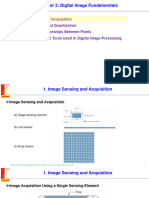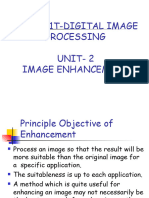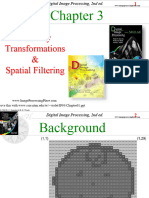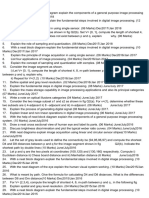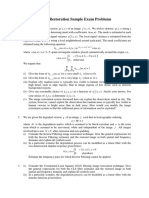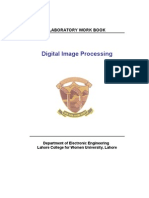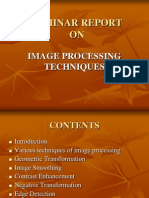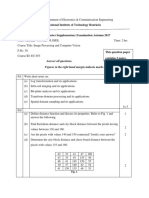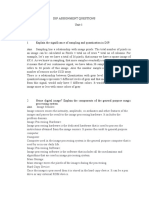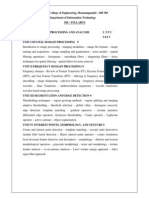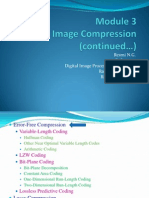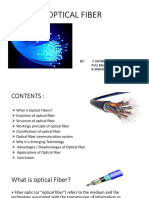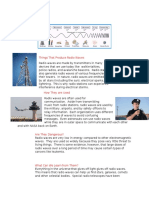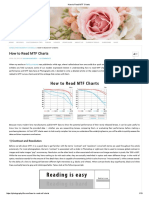Resmi N.G. Reference: Digital Image Processing Rafael C. Gonzalez Richard E.
Woods
�What is a digital image?
An array of real or complex numbers represented by a finite number of bits.
3/18/2012
CS 04 804B Image Processing - Module1
�What is digital image processing?
Processing of a two dimensional image using a computer. Digital processing of any two dimensional data for storage, transmission and machine perception.
3/18/2012
CS 04 804B Image Processing - Module1
�Three Types of Processing
Low-Level
Both inputs and outputs are images. Involves primitive operations such as image preprocessing to reduce noise, contrast enhancement, and image sharpening.
Middle-Level
Inputs are images; Outputs are attributes extracted from images. Involves image segmentation (partitioning image into regions), classification or recognition of individual objects.
3/18/2012
CS 04 804B Image Processing - Module1
�High-Level
Working with recognized objects as in image analysis. eg; automated analysis of text
I. II. III. IV.
V.
Acquiring image of area containing the text. Preprocessing Segmenting individual characters. Describing characters in a form suitable for computer processing. Recognizing the individual characters.
3/18/2012
CS 04 804B Image Processing - Module1
�Origin of Image Processing
One of the first applications of digital imaging was in the newspaper industry. Early 1920s- Introduction of The Bartlane Cable Picture Transmission system. Pictures were sent by submarine cable between London and New York. 5 distinct levels of grey.
3/18/2012
CS 04 804B Image Processing - Module1
�1929: Levels of grey increased to 15.
3/18/2012
CS 04 804B Image Processing - Module1
�1964: Pictures of moon transmitted by Ranger7 were processed using computers to correct various types of image distortion.
3/18/2012
CS 04 804B Image Processing - Module1
�Applications of DIP
Medical applications-to study X-ray images.
3/18/2012
CS 04 804B Image Processing - Module1
�Geographic Information Systems-to study pollution patterns from aerial and satellite images.
3/18/2012
CS 04 804B Image Processing - Module1
10
�Astronomy
3/18/2012
CS 04 804B Image Processing - Module1
11
�Applications classified based on their sources of energy
Electro-magnetic spectrum (gamma rays with highest energy to radio waves with lowest energy)
3/18/2012
CS 04 804B Image Processing - Module1
12
�Gamma-ray Imaging
Radioactive isotope emits positrons while it decays. Gamma rays are given off when a positron hits an electron. These are detected and image is created.
3/18/2012
CS 04 804B Image Processing - Module1
13
�X-ray Imaging
X-rays are generated using an X-ray tube(vacuum tube with a cathode and an anode).
3/18/2012
CS 04 804B Image Processing - Module1
14
�Imaging in Ultra Violet Band
3/18/2012
CS 04 804B Image Processing - Module1
15
�Imaging in Visible and Infrared Bands
3/18/2012
CS 04 804B Image Processing - Module1
16
�Remote sensing applications
3/18/2012
CS 04 804B Image Processing - Module1
17
�3/18/2012
CS 04 804B Image Processing - Module1
18
�Other areas of application
Microwave band Radar (explores inaccessible regions of earths surface) Radio band in medicine(Magnetic Resonance Imaging) and astronomy Acoustic Imaging (mineral and oil exploration over land and water) Synthetic Imaging Archaeology Physics Biology Defense Industry Machine perception
3/18/2012 CS 04 804B Image Processing - Module1 19
�Fundamental Steps in Digital Image Processing
3/18/2012
CS 04 804B Image Processing - Module1
20
�Image acquisition
Involves preprocessing such as scaling
3/18/2012
CS 04 804B Image Processing - Module1
21
�Image Enhancement
Brings out details that are obscured. Highlights certain features of interest in an image.
3/18/2012
CS 04 804B Image Processing - Module1
22
�Image Restoration
Improves appearance of an image Based on mathematical or probabilistic models of image degradation.
3/18/2012
CS 04 804B Image Processing - Module1
23
�Colour Image Processing
Colour is used to extract features of interest in an image.
3/18/2012
CS 04 804B Image Processing - Module1
24
�Wavelets and Multiresolution Processing
Wavelets are used:
for representing images in various degrees of resolution for data compression pyramidal representation
3/18/2012
CS 04 804B Image Processing - Module1
25
�Compression
Reduces the storage required to save an image or bandwidth required to transmit it.
3/18/2012
CS 04 804B Image Processing - Module1
26
�Morphological Processing
Tools for extracting image components that are useful in the representation and description of shape of image. eg; boundary extraction.
3/18/2012
CS 04 804B Image Processing - Module1
27
�Segmentation
Partitions image into its constituent parts or objects.
3/18/2012
CS 04 804B Image Processing - Module1
28
�Representation and description
Output of segmentation stage - Raw pixel data(either the boundary of a region or the region as a whole). Choosing a representation - one step in transforming raw data into form suitable for computer processing. Description(feature selection) deals with highlighting features of interest.
3/18/2012
CS 04 804B Image Processing - Module1
29
�3/18/2012
CS 04 804B Image Processing - Module1
30
�Object Recognition
Assigning labels to objects based on its descriptors.
3/18/2012
CS 04 804B Image Processing - Module1
31
�Image Representation
Each digital image consists of a finite number of elements called picture elements or pixels. Each pixel has a particular location and value. Image representation concerns with charaterization of the quantity that each pixel represents.
Luminances of objects Absorption characteristics of body tissue Radar cross-section of target Temperature profile of a region
3/18/2012 CS 04 804B Image Processing - Module1 32
�Definition for a Digital Image
Any two dimensional function that bears information is considered an image. An image is defined as a two-dimensional function f(x,y), where x and y are spatial coordinates. Amplitude of f at any pair of coordinates (x,y) is called intensity of image at that point. When x, y and amplitude values of f are all finite, discrete quantities, the image is called a digital image.
3/18/2012
CS 04 804B Image Processing - Module1
33
�Knowledge Base
3/18/2012
CS 04 804B Image Processing - Module1
34
�Knowledge about the problem domain. Details regions of an image where information of interest is known to be located. Advantage: limits the search. Controls the interaction between modules.
3/18/2012
CS 04 804B Image Processing - Module1
35
�Components of an Image Processing System
3/18/2012
CS 04 804B Image Processing - Module1
36
�Image Acquisition
Two elements:
Image sensors Digitizer Image sensor Physical device that is sensitive to the energy radiated by the object we wish to image. Digitizer Converts sensing device output to digital form.
3/18/2012
CS 04 804B Image Processing - Module1
37
�Specialized Image Processing Hardware
High speed front end subsystem. Two elements:
Digitizer Arithmetic and Logic Unit (ALU) ALU performs arithmetic and logical operations in parallel on entire images. eg; averaging images for noise reduction.
3/18/2012
CS 04 804B Image Processing - Module1
38
�Image Processing Software
Consists of specialized modules that perform specific tasks. User can write code utilizing these specialized modules.
3/18/2012
CS 04 804B Image Processing - Module1
39
�Mass Storage
A must for image storage Image of size 1024 x 1024 pixels in which intensity of each pixel is an 8-bit quantity requires 1 MB of storage space. 3 categories: Short-trem (during processing) Online storage (for fast access) Archival (infrequent access, massive storage)
3/18/2012 CS 04 804B Image Processing - Module1 40
�Short-term:
Computer memory Frame buffers
Online:
Magnetic disks Optical media
Archival:
Magnetic tapes Optical disks
3/18/2012
CS 04 804B Image Processing - Module1
41
�Image Displays
Color TV monitors
Hardcopy devices
Laser printers, cameras, heat-sensitive devices.
3/18/2012
CS 04 804B Image Processing - Module1
42
�Thank You
3/18/2012
CS 04 804B Image Processing - Module1
43



